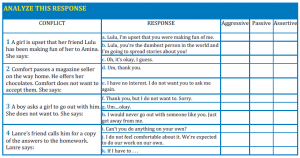We all have the right to express ourselves and our wishes. It might feel more difficult to speak your mind if someone disagrees, or if someone tries to pressure or intimidate you. To ‘assert’ means to express your beliefs, feelings and needs in a straightforward way, without infringing on the rights of other people. The skill required to do so is called assertiveness and this piece is focused on exactly that: How to stand up clearly for yourself and your rights without putting the other person down.
Being Assertive – How Is It Different from Being Aggressive, Manipulative and Passive?
Assertiveness involves firmness or clear and straightforward presentation of views, without oppressing others. Assertiveness is positive and affirming. Assertiveness invites the other person to have dialogue.
Aggressiveness means standing up for one’s rights at the expense of the rights of others. It is negative and demanding. Some examples are blaming, criticizing, starting an argument, or even being violent. It’s no surprise that aggressive communication is not good for relationships.
Manipulation involves using deceiving, misleading, lying, or blackmailing someone to get what you want. You can see that it is not the same as being straightforward and assertive.
Passiveness is failing to express one’s needs and feelings at all, or expressing them so weakly or indirectly that you will be either misunderstood or ignored.
Benefits of Assertiveness
Asserting yourself can make a big difference. Learning to be assertive can also help you meet your own goals. For example, you can learn to tell a teacher you’d like a special responsibility. You can clearly communicate a request to a friend or family member.
Being assertive can also help you resist pressure to do something you do not want to do. This may be resisting peer pressure to skip your homework. It may be knowing what to say and do if you experience sexual harassment. It can also help you avoid or resist pressure from someone who tries to force you to have sex.
People tend to admire others who are assertive and respectful. They are more likely to have honest relation- ships and to achieve what they want.
Basic Assertiveness Skills
It is easier to be assertive if you know your own values and have good communication skills. You can practice speaking up for yourself. This can include seeking opportunities (such as seeking a school leadership position), asserting your rights (such as not wanting to be married off while you are a child), or refusing things that other people want from you that are not what you think is best for yourself.
Do not be afraid to set limits and to repeat your message. If you are true to yourself and honest, you will be proud of yourself.
Here are some tips to help you be more assertive, whether you are initiating a discussion or responding to someone:
1. Know what is most important to you. This helps you draw boundaries and keep them. For example, “Protecting my health” or “Not getting in trouble” may be your priorities.
2. Take a clear position: Convey your message calmly, honestly, directly, and courageously. For example, “I want to apply to be a student leader. I’d like to ask for your support.”
3. Use “I” statements. Rather than putting your message in terms of someone else, speak up on your own behalf. Say what you want or feel.
4. Practice assertive body language: Your body language should match your message. Stand straight, look someone in the eye, practice using a strong tone of voice (Smiling while you refuse something may lead to your being misunderstood).
5. Give reasons for your position (especially if it is not a stranger), such as: “I’d like have a pet because I’m lonely at home most times since my brother left for boarding school“, or “No, keeping late nights exposes me to danger”, or “No, I have decided to finish school before dating” or “No, we could get expelled” or “No, I am too young to marry”, or “No, I don’t like being around people who are always drinking alcohol or smoking cigarette”, “I want to continue to university because it will prepare me to have a satisfying career.”
6. Turn the discussion: If need be, try saying something like: “I always thought you were smarter than that” or “I can’t believe you would ask me to do that. I thought you were my friend”.
7. Rely on your instincts or self-conviction: If a situation doesn’t feel right, it probably isn’t right. If you are in danger, leave immediately without discussion. Walk away with a confident attitude. Be sure not to return to that same scene as that may suggest you have had a change of mind.
The “ASSERT” Formula
Another way to think about assertiveness is the following formula of what assertiveness entails:
Why Isn’t Everyone Assertive?
Cultural norms sometimes get in the way of being assertive. Some people fear that if they are assertive, their behaviour will be misunderstood as rudeness or aggressiveness. Someone might think you are ‘over-reacting’ by stating your feelings directly. It is even possible that if you are assertive, someone in authority might even punish you for being ‘disrespectful.’
When the two people communicating do not have the same social status, it can make it difficult for the person with less power or status to be direct. For example, in a marriage where the husband has absolute control, the wife and children may not feel the liberty to speak directly. In a marriage that is more equal, it is more likely that family members will feel freedom to assert their ideas or feelings.
Similarly, because as children we are taught to be respectful of adults, some young people remain submissive even if they are in a situation where they do not feel safe.
Self-assessment: How do I communicate when I am feeling uncomfortable?
Do you communicate more directly and respectfully in some situations than in others? Take this self-assessment quiz to learn more about your own style of communication.
When I am in an uncomfortable situation with a boy, I tend to be:
- Passive
- Assertive, respectful
- Aggressive
- Indirect or manipulative
When I am in an uncomfortable situation with a girl, I tend to be:
- Passive
- Assertive, respectful
- Aggressive
- Indirect or manipulative
When I am in an uncomfortable situation with an adult male, I tend to be:
- Passive
- Assertive, respectful
- Aggressive
- Indirect or manipulative
When I am in an uncomfortable situation with an adult female, I tend to be:
- Passive
- Assertive, respectful
- Aggressive
- Indirect or manipulative
When I am in an uncomfortable situation with someone whom I do not view as my equal, I tend to be:
- Passive
- Assertive, respectful
- Aggressive
- Indirect or manipulative
- I cannot answer this because I view everyone as my equal
For me, expressing feelings of anger is:
- Fairly easy (but I sometimes respond aggressively)
- Fairly easy (and I never respond aggressively or with violence)
- Neither easy nor difficult
- Somewhat or very difficult
For me, expressing when I feel vulnerable or weak is:
- Fairly easy (but I sometimes respond aggressively)
- Fairly easy (and I never respond aggressively or with violence)
- Neither easy nor difficult
- Somewhat or very difficult
- Assertive responses are: a; e; f; j.
- Passive responses are: c; d; g; k.
- Aggressive responses are: b; h; i
Takeaway Message
Assertiveness is the act of expressing your belief, feelings and needs without violating the rights of other people. Assertiveness is not the same as aggressiveness or manipulation. Being assertive has many advantages; particularly, it can help you feel respected and safe as well as build honest relationships. However, certain factors such as culture and gender roles may make it difficult for individuals to be assertive. Remember, everyone can learn to be more assertive –it’s a skill worth developing.
This article is adapted from Action Health Incorporated’s publication – “Family Life and HIV Education Students’ Handbook for Junior Secondary Schools”








You must be logged in to post a comment.